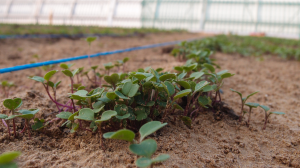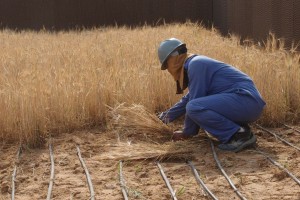By Joakim Hauge, CEO of The Sahara Forest Project on the World Day to Combat Desertification
Do you think a desert always has to be a desert? Think again. Many desert areas were once lush and green. Fortunately, we can turn the challenges of desertification into a profitable and climate smart solutions aided by the synergies of existing innovative technologies.
Today is the World Day to Combat Desertification. In 193 countries there are now appeals to combat one of the largest global challenges. The rate of desertification is increasing 30 times faster than ever before in the history of mankind.
Last year, 12 million hectares – an area the size of 15 million football fields – were transformed into desert.
Our generation may be the last to have the freedom to decide what we can eat and where we can live. Our freedom is created by how we have managed some of the world’s natural resources such as arable land, fresh water access, energy production, flora and fauna as well as the rainforests.
Historically the extractive use of resources have transformed 2 billion hectares into desert. Try to imagine that we and our ancestors have contributed to spreading the desert to a global area of a staggering 2.5 billion football fields.
An easier way to explain this is that for every three hectares arable land the world once had, one hectare now has become unsuitable for food production.
The way Julis Caesar and his fellow Roman rulers exploited what we now call the Sahara Desert as their bread basket and treasury for timber and other valuable biomass is one of several historical examples of how humanity has prioritized short-term, time-limited pleasures rather than long-term, sustainable management of natural resources.
Now the way we live are threatened. We must rethink the way we use our resources and the way our production systems work.
2.5 billion people will live in dry areas
According to the United Nations, arid areas cover around 30 percent of the Earth’s land surface. It is estimated that two billion people are living in these areas today.
In 2025, an estimated additional 500 million people will be affected if desertification continues with the same pace. If the UN scenario will prove correct, then every fifth citizen of the world will be living in areas with drought.
90 percent of this group will be living in developing countries. It would be extremely naive to think that these people will see a livelihood and will remain in the countries they are born.
According to the UN Climate Panel (IPCC) around 200 million people are right now exposed to freshwater shortages due to climate change. An overwhelming majority of the world’s climate scientists point out that this trend is due to greenhouse gas emissions. Drought and floods are becoming more intense and unpredictable for hundreds of millions of farmers worldwide.
Today it is important to reflect on these questions. Which world do we want to leave behind us? We have the time, knowledge and money to change and reverse the trends. It requires that we prevent new greenhouse gas emissions and we also adapt to climate change. Both of these approaches require a new way of thinking about resources and production systems. We must restore land that has been destroyed by desertification.If we revegetate desert areas, and produce food, renewable energy and fresh water at the same time, we can contribute to climate challenge, stop desertification and simultaneously meet the demand from over 9 billion people who will inhabit the planet in 2050.
According to the UN, there is a risk that up to 60 million Africans will to leave their homes because of desertification by 2025, as two thirds of the continent’s arable land could be desertificated. Food security and desertification is closely interlinked. Social development is in jeopardy. Also if you are concerned about security policy, there is a fear that an increasing level of unemployed youngsters will be driven into the hands of militant groups.
Syria- a frightening example
Monique Barbut is the General Secretary of UNCCD, the UN Convention to Combat Desertification. She claims warmer climate change was one of the driving forces behind the conflict in Syria.A report from the UNCCD shows that Syria experienced strong drought between 2006-2011. Climate change combined with misguided political handling contributed to 75 per cent of Syrian farmers experienced the crops failed. 85 percent of farmers lost their livestock. This contributed greatly to the fact that angry and desperate people from the countryside moved to big cities that did not have the capacity to receive them. It’s not just Africa and the Middle East that are facing the challenges of desertification. One third of all countries in the Mediterranean region are vulnerable. Around 85 percent of America’s pastures are threatened by drought. The sum of these challenges requires political, moral and financial action.
What are the solutions to combat desertification?
Last year 193 countries signed an international agreement where they will strive to reach a goal of becoming “land degradation neutral”. It means that the countries promised each other to maintain the proportion of arable land within national boundaries the next 15 years and beyond, or preferably increase the proportion of productive land. 90 countries have signed an ambitious agreement to restore more land than what is degraded. The efforts of those 90 are admirable, but on the other hand the United Nations points out that 169 countries are directly affected by drought. We at the Norwegian-registered company The Sahara Forest Project believes the promises must provide viable conditions for sustainable projects that give young people hope for the future. We see it as an important mission to create green jobs in order to produce food, clean energy and water in a climate smart way in desert areas. Desertification and drought need to be combated through holistic approached. The Sahara Forest Project see food production, access to fresh water and energy production as interlinked. Our business model uses what we have too much of – sun, salt water, deserts and CO2 – to produce what we need more of: food, fresh water and clean energy.
Our company was this week invited to a major UN meeting organized by the Global Alliance for Climate Smart Agriculture (GACSA) in Rome. The coalition of willing national governments, researchers, NGOs and businesses stressed that there is a growing need for climate smart agriculture which can contribute to increased food security on all continents. Innovation in desert areas will be crucial to reach this target. Fortunately, there are technologies that can reverse desertification and revegetate desert areas. Therefore, if you want to celebrate the World Day for Combating Desertification, we need your hearts and minds to help to move decision makers in politics and finance to demand climate smart agriculture with more than words and great speeches.
If they do, it will be good for climate and environment, it will be good for social development, and it will be good for business.




